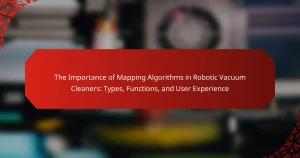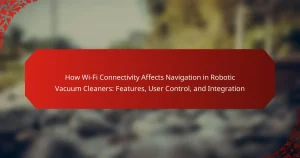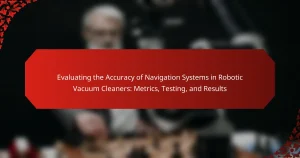SLAM (Simultaneous Localization and Mapping) technology enables robotic vacuum cleaners to create dynamic, real-time maps of their environments, enhancing navigation and cleaning efficiency. Unlike traditional navigation methods that rely on pre-defined paths and basic obstacle avoidance, SLAM adapts to changes in the environment, allowing for optimized cleaning routes and reduced cleaning times by up to 30%. This article compares SLAM and traditional navigation, highlighting their principles, advantages, and applications in various settings, including homes with intricate layouts and open commercial spaces. Users can make informed decisions based on their specific cleaning needs and home characteristics.
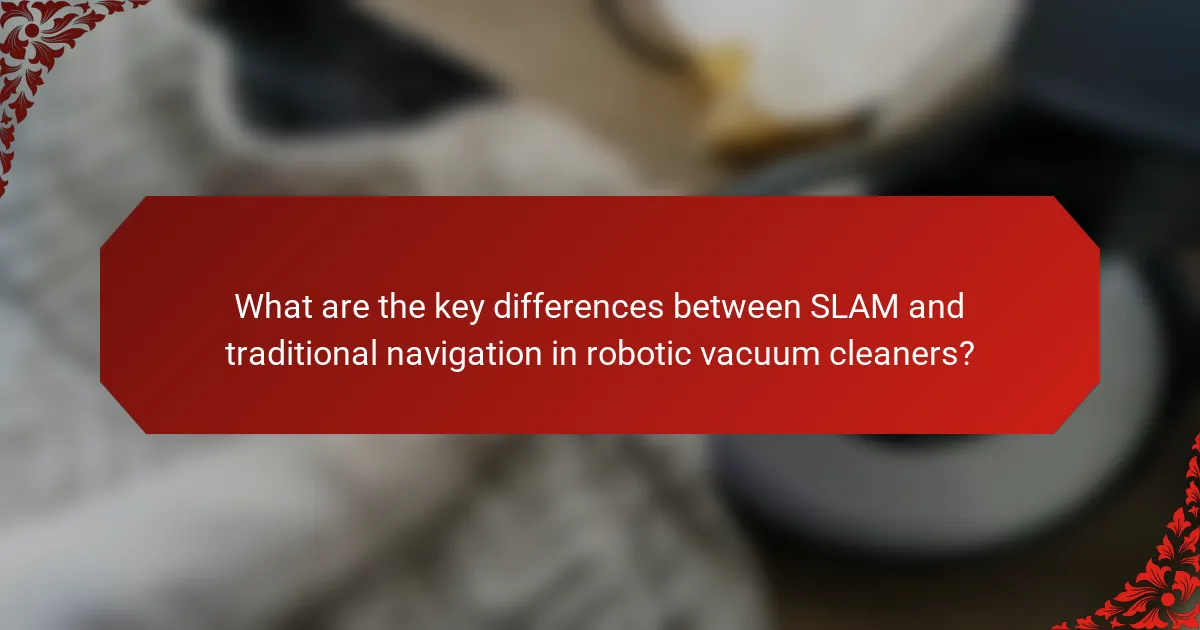
What are the key differences between SLAM and traditional navigation in robotic vacuum cleaners?
SLAM (Simultaneous Localization and Mapping) enables robotic vacuum cleaners to create real-time maps of their environment while navigating. Traditional navigation relies on pre-defined maps or simple obstacle avoidance techniques. SLAM allows for dynamic mapping, adapting to changes in the environment, while traditional methods are static and less flexible.
Robotic vacuum cleaners using SLAM can efficiently cover larger areas without missing spots. In contrast, traditional navigation may lead to repeated cleaning of the same areas. SLAM technology enhances the robot’s awareness of its surroundings, improving efficiency and cleaning performance. Traditional navigation often results in inefficient paths and longer cleaning times.
Research indicates that SLAM-equipped devices can reduce cleaning time by up to 30% compared to traditional navigation methods. This efficiency stems from SLAM’s ability to optimize routes based on real-time data.
How does SLAM technology function in robotic vacuum cleaners?
SLAM technology in robotic vacuum cleaners functions by simultaneously mapping the environment and locating the vacuum within that map. This process involves sensors that collect data about the surroundings. The vacuum uses this data to create a real-time map of the area it is cleaning. Algorithms process the sensor data to identify obstacles and navigate efficiently. By continuously updating the map, the vacuum can adapt to changes in the environment. This allows for effective cleaning paths and coverage. Studies show that SLAM-equipped vacuums improve cleaning efficiency compared to traditional navigation methods.
What are the core components of SLAM technology?
The core components of SLAM technology are sensors, algorithms, and maps. Sensors gather data about the environment. Common sensors include LIDAR, cameras, and ultrasonic sensors. Algorithms process the sensor data to estimate the robot’s position. Popular algorithms used in SLAM include Extended Kalman Filter and Particle Filter. Maps are created to represent the environment as the robot navigates. These maps can be 2D or 3D, depending on the application. Together, these components enable a robot to navigate and understand its surroundings autonomously.
How does SLAM map and navigate an environment?
SLAM, or Simultaneous Localization and Mapping, maps and navigates an environment by creating a map while keeping track of the location within that map. It employs sensors to gather data about the surroundings. These sensors can include cameras, LiDAR, and ultrasonic devices. The data collected is used to identify landmarks and obstacles. SLAM algorithms process this data to build a map incrementally. At the same time, the system calculates its position relative to the map. This dual process enables real-time navigation and adaptation to changes in the environment. SLAM is widely used in robotic vacuum cleaners for efficient path planning and obstacle avoidance. Studies show SLAM improves navigation accuracy in dynamic environments, making it a preferred choice over traditional methods.
What are the principles behind traditional navigation methods?
Traditional navigation methods rely on fixed reference points and environmental features. These methods utilize landmarks, maps, and compass readings for orientation. The principles include dead reckoning, which calculates position based on previously known locations. Celestial navigation uses the stars for guidance, while terrestrial navigation involves physical landmarks. Traditional methods often require manual input and adjustment for accuracy. Historical evidence shows that ancient mariners used these techniques for successful long-distance travel. These principles have been foundational in the evolution of navigation technologies.
What types of sensors are used in traditional navigation?
Traditional navigation uses several types of sensors. Commonly utilized sensors include GPS, gyroscopes, accelerometers, and magnetometers. GPS provides geolocation data for positioning. Gyroscopes measure angular velocity, aiding in orientation. Accelerometers detect changes in movement and speed. Magnetometers sense magnetic fields for directional information. These sensors work together to improve navigation accuracy. Their integration allows for reliable pathfinding in various environments.
How do traditional navigation systems determine the robot’s position?
Traditional navigation systems determine a robot’s position using predefined maps and sensor data. They rely on techniques such as dead reckoning and landmark recognition. Dead reckoning calculates the robot’s current position based on its last known position and movement data. This method accumulates errors over time, which can lead to inaccuracies. Landmark recognition involves identifying known features in the environment to correct the robot’s position. Sensors like ultrasonic, infrared, or laser rangefinders are commonly used to gather data for these methods. The combination of these techniques allows traditional navigation systems to estimate the robot’s location within a mapped area.
What advantages do SLAM systems offer over traditional navigation?
SLAM systems provide real-time mapping and localization, which enhances navigation accuracy. They create detailed maps of the environment while simultaneously tracking the device’s position. This capability allows for efficient path planning and obstacle avoidance. Traditional navigation methods often rely on pre-existing maps, limiting adaptability. SLAM systems can operate in dynamic environments where changes occur frequently. Studies show that SLAM technology significantly reduces navigation errors compared to traditional methods. For instance, a comparison found that SLAM improved navigation accuracy by up to 30% in cluttered spaces. This adaptability makes SLAM systems suitable for various applications, including robotic vacuum cleaners.
How does SLAM improve cleaning efficiency and coverage?
SLAM improves cleaning efficiency and coverage by enabling robots to create real-time maps of their environment. This technology allows robotic vacuum cleaners to navigate complex spaces more effectively. SLAM algorithms process data from sensors to identify obstacles and determine optimal cleaning paths. As a result, these robots can cover more area in less time compared to traditional navigation methods.
Traditional systems often rely on pre-defined patterns, which can lead to missed spots. In contrast, SLAM adapts to changes in the environment, ensuring thorough cleaning. Studies show that SLAM-equipped robots can achieve up to 30% better coverage than their non-SLAM counterparts. This efficiency translates to reduced cleaning time and improved overall performance.
What are the limitations of traditional navigation systems?
Traditional navigation systems have several limitations. They often rely on pre-mapped environments, which restricts their adaptability. These systems can struggle in dynamic or unfamiliar spaces. They may fail to account for obstacles not present in the original map. Accuracy can decrease in large or complex areas. They typically require manual updates to the map, which can be time-consuming. Additionally, traditional systems may have limited sensor capabilities, affecting their performance in various conditions. These factors hinder their effectiveness compared to more advanced navigation methods.
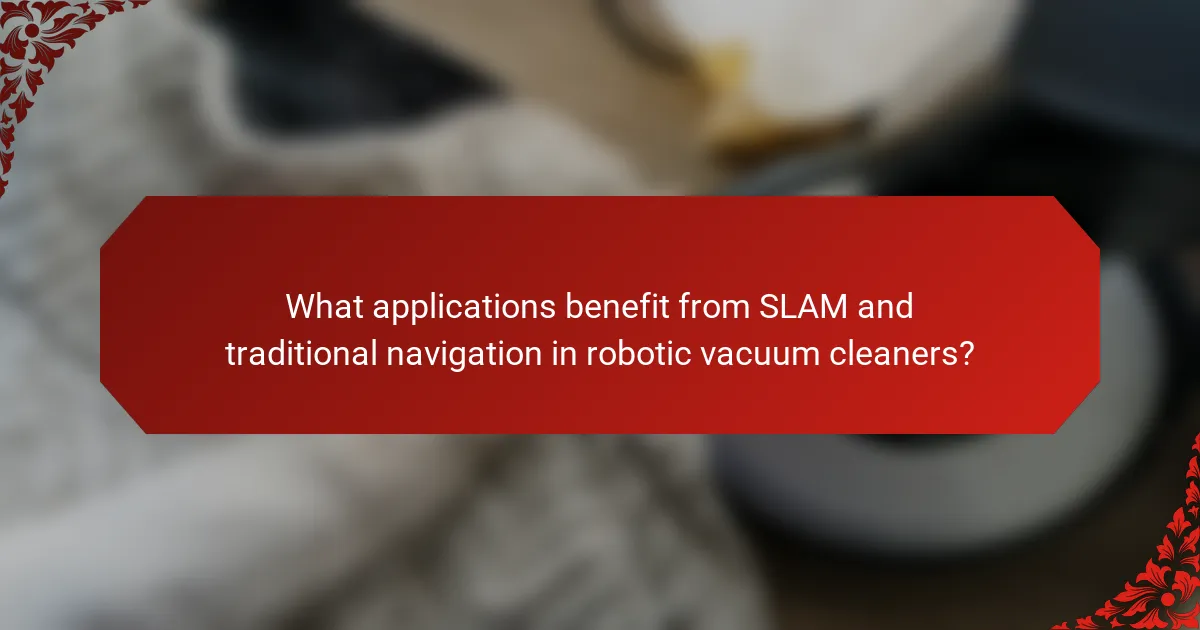
What applications benefit from SLAM and traditional navigation in robotic vacuum cleaners?
Robotic vacuum cleaners benefit from applications such as home cleaning, commercial cleaning, and industrial environments. SLAM (Simultaneous Localization and Mapping) enhances navigation in complex spaces. It allows vacuums to map their surroundings in real-time. This leads to efficient cleaning paths and avoidance of obstacles. Traditional navigation relies on pre-defined paths and basic sensors. It is suitable for simpler layouts where mapping is unnecessary. Both methods are used in various settings. For example, SLAM is beneficial in homes with furniture and varying room shapes. Traditional navigation works well in open spaces like warehouses. The choice of navigation method impacts cleaning efficiency and effectiveness.
In what environments is SLAM particularly advantageous?
SLAM is particularly advantageous in dynamic and unstructured environments. These include places like homes with furniture, cluttered offices, and outdoor areas. In these settings, SLAM can effectively map the surroundings while simultaneously localizing the device. This capability allows for real-time adjustments to the robot’s path. SLAM also excels in environments where GPS signals are weak or unavailable. Examples include indoor spaces and underground locations. The technology enables robots to navigate efficiently without pre-existing maps. This adaptability is crucial for tasks such as cleaning and exploration.
How does SLAM adapt to dynamic environments?
SLAM adapts to dynamic environments by continuously updating its map and localization based on real-time sensor data. This process involves detecting and tracking moving objects within the environment. SLAM algorithms utilize techniques such as data association and loop closure to maintain accuracy. For instance, when a robot encounters a new obstacle, it recalibrates its position and adjusts the map accordingly. Additionally, SLAM employs probabilistic models to predict the movement of dynamic objects. This allows the system to differentiate between static and dynamic features. Consequently, SLAM enhances navigation efficiency in unpredictable settings. Research has shown that SLAM can maintain performance even in environments with significant changes, such as moving furniture or people.
What specific use cases highlight the effectiveness of SLAM?
SLAM is effectively used in robotic vacuum cleaners for navigation and mapping. It allows these devices to create detailed maps of their environment. This capability enables efficient cleaning paths and obstacle avoidance. For example, a robotic vacuum can navigate complex room layouts without human intervention. Another use case includes real-time adjustments to cleaning routes based on detected obstacles. Research shows that SLAM improves cleaning efficiency by up to 30% compared to traditional methods. Additionally, SLAM facilitates multi-room cleaning by seamlessly transitioning between spaces. This technology enhances user experience through app-based monitoring and control. Overall, SLAM significantly optimizes the performance of robotic vacuum cleaners.
Where is traditional navigation still relevant?
Traditional navigation is still relevant in environments where GPS signals are weak or unavailable. This includes indoor spaces, dense urban areas, and underwater settings. In these scenarios, traditional navigation methods like landmarks and dead reckoning are crucial. For example, robotic vacuum cleaners often rely on these methods when operating inside homes. They use sensors to detect walls and furniture, enabling them to map their surroundings. Additionally, traditional navigation is essential for tasks requiring precise localization. This is particularly true in industrial applications where GPS cannot be relied upon. Therefore, traditional navigation methods remain vital in various contexts, ensuring effective operation where modern systems fall short.
What scenarios favor traditional navigation methods?
Traditional navigation methods are favored in environments with clear landmarks and defined paths. These methods rely on fixed reference points, making them effective in structured spaces. For example, traditional navigation excels in homes with distinct room layouts. It also performs well in smaller areas where GPS signals may be weak or unavailable. In such cases, robots can use pre-mapped data to navigate efficiently. Additionally, traditional methods are beneficial in environments with minimal obstacles. They can provide consistent performance without the complexity of real-time mapping. Overall, these scenarios highlight the effectiveness of traditional navigation in specific settings.
How do cost considerations affect the choice between SLAM and traditional navigation?
Cost considerations significantly influence the choice between SLAM and traditional navigation in robotic vacuum cleaners. SLAM technology typically incurs higher initial costs due to advanced sensors and processing capabilities. In contrast, traditional navigation systems are generally less expensive, relying on simpler sensors and algorithms. The total cost of ownership also varies; SLAM can reduce operational costs over time through efficiency gains. For instance, SLAM-equipped robots may require less maintenance due to better mapping and obstacle avoidance. Additionally, the long-term value of enhanced features in SLAM can justify the upfront investment for consumers seeking advanced performance. Therefore, cost considerations play a critical role in determining the most suitable navigation method for specific consumer needs.
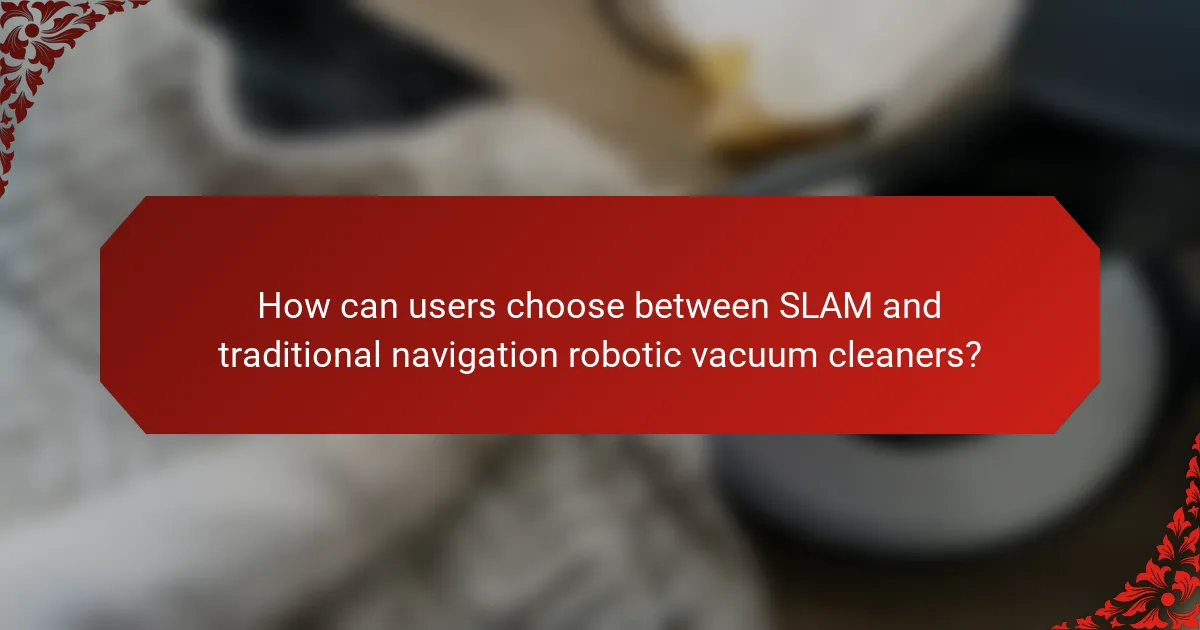
How can users choose between SLAM and traditional navigation robotic vacuum cleaners?
Users can choose between SLAM and traditional navigation robotic vacuum cleaners based on their cleaning needs and home layout. SLAM (Simultaneous Localization and Mapping) offers real-time mapping and efficient navigation. It adapts to changes in the environment, making it suitable for complex layouts. Traditional navigation relies on pre-set patterns and can struggle in cluttered spaces. Users with larger, open areas may prefer traditional models for simplicity. In contrast, those with intricate floor plans benefit from SLAM’s advanced capabilities. Research shows SLAM-equipped vacuums clean more thoroughly in dynamic environments. Therefore, users should assess their home’s characteristics to make an informed decision.
What factors should consumers consider when selecting a robotic vacuum cleaner?
Consumers should consider suction power, battery life, navigation technology, and dustbin capacity when selecting a robotic vacuum cleaner. Suction power affects cleaning efficiency on various surfaces. Battery life determines how long the vacuum can operate before needing a recharge. Navigation technology, such as SLAM (Simultaneous Localization and Mapping) or traditional methods, impacts how effectively the vacuum can navigate and clean an area. Dustbin capacity influences how often it needs to be emptied during use. These factors collectively influence the overall performance and user experience of the robotic vacuum cleaner.
How do cleaning needs influence the choice of navigation technology?
Cleaning needs significantly influence the choice of navigation technology in robotic vacuum cleaners. Different environments require varying levels of navigation precision. For instance, homes with complex layouts benefit from SLAM (Simultaneous Localization and Mapping) technology. SLAM allows robots to create detailed maps and navigate efficiently in cluttered spaces. In contrast, traditional navigation methods may suffice for simpler, open areas. Cleaning frequency and surface types also dictate navigation choices. High-traffic areas with diverse flooring types necessitate advanced navigation to ensure thorough cleaning. Data shows that robots using SLAM can clean up to 30% more area in complex environments compared to those using traditional methods. Thus, specific cleaning needs directly determine the most effective navigation technology for robotic vacuum cleaners.
What are the common features to look for in SLAM-enabled devices?
Common features to look for in SLAM-enabled devices include real-time mapping and localization capabilities. These devices utilize sensors to create accurate maps of their environment. They can navigate complex spaces without predefined paths. Additionally, they often feature obstacle detection and avoidance systems. This ensures safe navigation around furniture and other obstacles. Another important feature is the ability to update maps dynamically as the environment changes. Many SLAM-enabled devices also support multi-floor mapping. This allows them to operate in different levels of a building seamlessly. These features enhance efficiency and effectiveness in robotic applications.
What tips can help users maximize the performance of their robotic vacuum cleaners?
Regularly clean the vacuum’s brushes and filters to maintain optimal performance. Clogged brushes and dirty filters reduce suction power. Schedule cleaning sessions during off-peak hours for uninterrupted operation. Ensure the vacuum’s sensors are unobstructed for accurate navigation. Use boundary markers to prevent the vacuum from entering undesired areas. Keep the floors clear of obstacles to enhance efficiency. Charge the vacuum fully before use to maximize runtime. Update the vacuum’s firmware regularly to benefit from performance improvements.
How can users maintain their robotic vacuum for optimal performance?
Users can maintain their robotic vacuum for optimal performance by regularly cleaning its components. This includes emptying the dustbin after each use to prevent clogs. Users should also clean the filters monthly to ensure proper airflow. Additionally, brushing the rollers and wheels helps remove hair and debris. Checking for software updates is essential for improved functionality. Users should also inspect the sensors for dirt or obstructions, as this affects navigation accuracy. Keeping the charging dock clear of obstacles ensures efficient recharging. Following these maintenance steps can prolong the vacuum’s lifespan and enhance its cleaning efficiency.
What troubleshooting steps can resolve common navigation issues?
Check the robot’s sensors for obstructions or dirt. Clean the sensors to ensure accurate readings. Restart the robotic vacuum to reset its navigation system. Update the firmware if available, as updates can fix bugs. Verify that the charging station is functional and properly placed. Ensure the floor is free from obstacles that may confuse the navigation system. Test the robot in a different environment to identify if the issue persists. Consult the user manual for specific troubleshooting steps related to the model.
The main entity of this article is the comparison between SLAM (Simultaneous Localization and Mapping) and traditional navigation methods in robotic vacuum cleaners. The article examines the fundamental differences between these two navigation technologies, highlighting SLAM’s ability for real-time mapping and dynamic navigation, which enhances efficiency and cleaning performance. It discusses the core components of SLAM, its advantages over traditional methods, and the specific applications where each technology excels. Additionally, the article outlines factors consumers should consider when choosing between SLAM and traditional navigation robotic vacuum cleaners, along with common features and maintenance tips for optimal performance.
